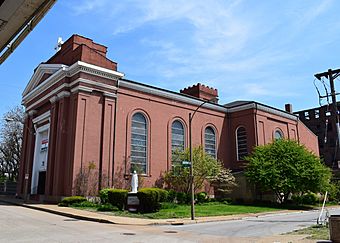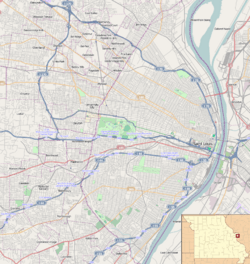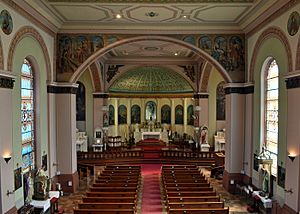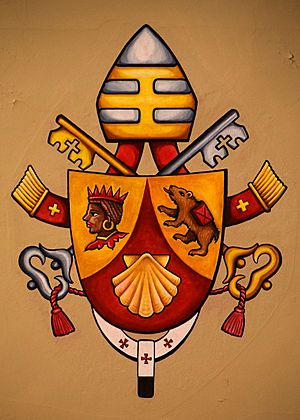St. Mary of Victories Church facts for kids
Quick facts for kids |
|
|
St. Mary of Victories Church
|
|

Exterior
|
|
| Location | 744 S. 3rd St., St. Louis, Missouri |
|---|---|
| Area | less than one acre |
| Built | 1843 |
| Architect | George I. Barnett and Franz Saler |
| Architectural style | Mannerist |
| NRHP reference No. | 80004510 |
| Added to NRHP | August 28, 1980 |
The Church of St. Mary of Victories is a very old Catholic church in downtown St. Louis, Missouri. It is located in an area called Chouteau's Landing Historic District, which is south of the famous Gateway Arch. This church was built in 1843 and was the second Catholic church ever built in St. Louis. It is now listed on the National Register of Historic Places, which means it's an important historical site.
Contents
A Look Back: The Church's History
This church was first built for about 500 families who had moved to St. Louis from Germany. It was in a busy area where many German immigrants settled before the American Civil War. The church got its name from a special day celebrated by Pope Pius V. This day honored a big victory by Christian forces in a battle at sea in 1571.
Serving Different Communities
For about 100 years, St. Mary's was the main church for the German Catholic people in St. Louis. Later, it also welcomed a small group of people from Lebanon. These families eventually started their own church, which is now St. Raymond Maronite Cathedral.
In the 1950s, many German families moved away from the city. After World War II and the Hungarian Revolution of 1956, many refugees from Hungary came to St. Louis. They brought new life to the church, and it became known as the "Hungarian Church."
Special Status and Closing
The church was added to the National Register of Historic Places in 1980. It is also a "consecrated" Roman Catholic church. This means it was specially dedicated by Pope Pius IX in 1866. During this dedication, the walls were anointed with special oil. This makes sure the church is only used for Catholic worship.
In 2005, the church stopped being a regular parish. Instead, it became a chapel, which is a smaller place for worship.
Exploring the Church's Design
The architects, George I. Barnett and Franz Saler, designed St. Mary's Church in a style called Mannerist. This style was popular in the early 1500s. The main part of the church, called the nave, is shaped like a rectangle. With the side sections, called the transept, it forms a cross shape.
Inside the Church
At the back of the church, there's a two-level balcony. The choir loft is on the second level. The church has a beautiful, old organ with fancy wooden carvings. Eight tall stained-glass windows with rounded tops let light into the main area. The entrance has a grand doorway with two large pillars.
The inside of St. Mary of Victories is special because its design was based on careful studies of church worship. Max Schneiderhahn, a German artist, created many of the beautiful pieces inside. He designed and made the altars, statues, baptismal font, and paintings, including the Stations of the Cross.
Honoring Important Figures
The church also has other special art and items. These were given by different Catholic groups, especially those with German roots. There is a statue of Blessed Francis X. Seelos, a priest who worked with German immigrants in the 1800s.
A white marble plaque in the church honors Joseph Cardinal Mindszenty from Hungary. He visited the church in the 1970s. Cardinal Mindszenty is seen as a hero for standing up against communism in the 1950s. The Hungarian Ladies Society of the church has also embroidered many of the beautiful altar cloths.
The church ceiling also features the special symbols, or "coats of arms," of two recent popes. Pope John Paul II's blue and gold symbol is over the main crossing of the church. Pope Benedict XVI's symbol is over the choir loft. St. Mary's was the only German-background church in the area to display Pope Benedict XVI's coat of arms in its building.
Important Connections and People
Blessed Francis Xavier Seelos
It was at St. Mary of Victories that Blessed Francis Xavier Seelos, a Redemptorist priest, first preached in Missouri. He gave a special series of sermons in German in October 1865. A side altar in the church honors his important role.
The Sisters of St. Mary
In 1872, five women came to St. Louis from Germany. They were led by Mother Mary Odilia Berger. They had to leave Germany because of government policies that made it hard for them to live their religious lives. They found a place to stay in the attic of the church complex.
In 1874, these women formed a new religious group called the Franciscan Sisters of St. Mary. They took their name from the church. Today, their work continues through SSM HEALTH CARE SYSTEMS. This organization runs hospitals and medical centers across the Midwest and Mid-South. A bronze plaque near the church entrance remembers the founding of the Sisters of St. Mary in America.
External Links
- St. Mary of Victories Website






